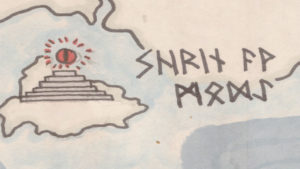In July of 2012 I launched a Kickstarter for Conspiracy of Shadows: Apprentice. I wrote the initial draft in a flurry one night after noodling on the nature of the Master/Apprentice relationship outlined in the Star Wars comics. I always found that dynamic interesting and so wrote this game for Conspiracy of Shadows to explore it while at the same time capturing the culture of a part of the world I have been creating and recreating for years.
This page contains the complete rules for the game as well as links to any play aids you might need. If web-based rules aren’t your thing, you can purchase copies of the game on Magcloud. You can also read about how the game plays via a write up by Tim Koppang of Mars Colony fame.
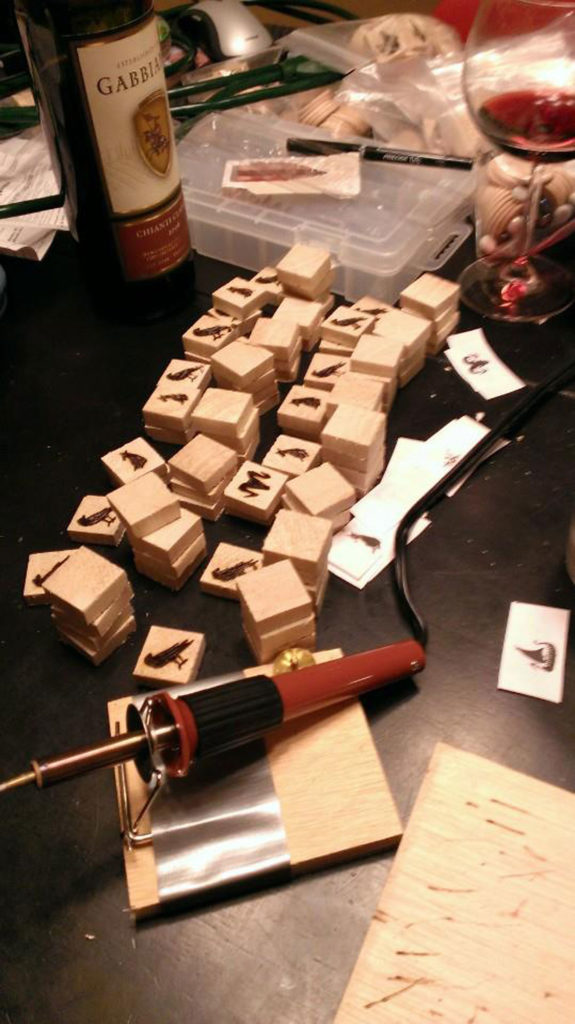
This project was the first time I got into wood burning. For certain backers I created custom game pieces and a wooden Futhark set.
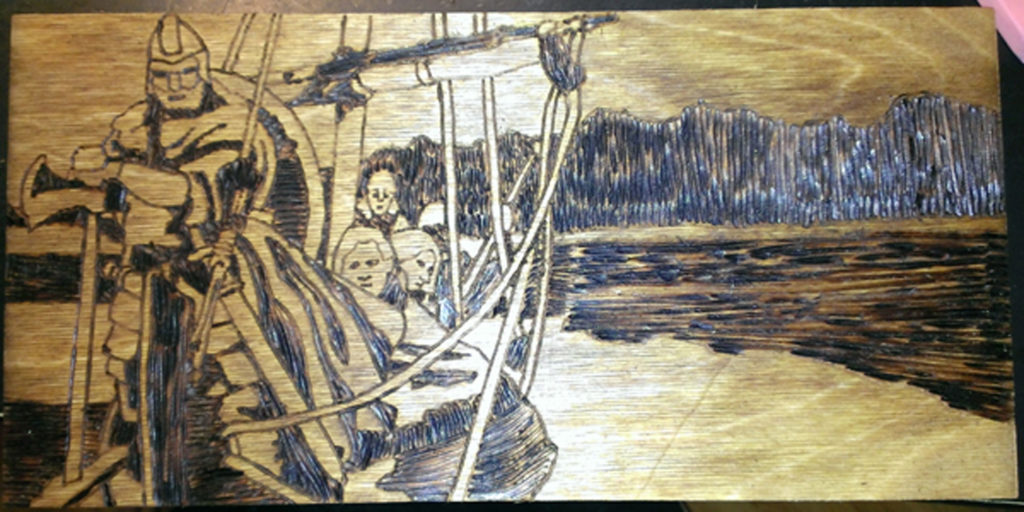
Some backers got wooden versions of some of the illustrations in the book, like this one of Haltaf the Dour.
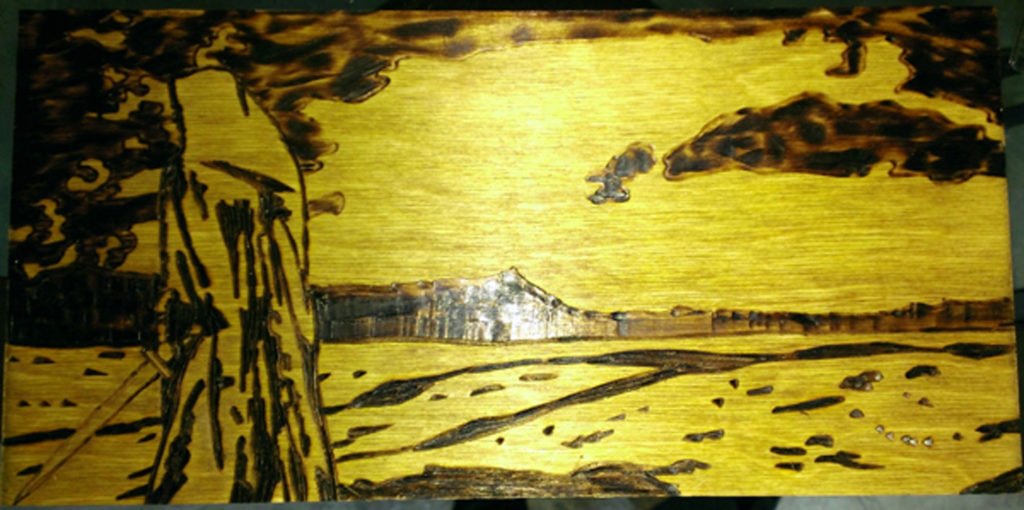
Drawing with a wood burning tool is an interesting challenge. You have to learn how to accept the imperfections that occur, much like painting.
There can only ever be one Master Galgarmr and one Apprentice at any given time. This is the law set down when the Jutun ruled the north with their alien sorcery. Thus, the Apprentice did as he should, seeking to strike down his master and replace him. He failed and was sacrificed to the Cold Gods. Shackled to an iceberg, he was cast adrift to freeze as a proper sacrifice. He refused. In the dark, frigid north he found an icebound ship with 4 starving warriors on a quest to destroy a great evil… His Master.
Conspiracy of Shadows: Apprentice is intended for three to nine players who will play out the confrontation between the Apprentice and the Master together with their respective followers. Prior to play beginning, each player must select a role in the following order:
Any Warrior character not chosen, does not appear in the game. If there are more than 6 players, the remaining players choose from among the Master’s Minions. Any Minion not chosen by a player is controlled directly by the Master.
The game requires 20 stones or other tokens to represent Destiny. Each character begins with a set number of Destiny Stones and will spend and earn more throughout play.
When Destiny Stones are spent they are placed in a pool on the table and are taken from this pool when earned. If there aren’t any stones in the pool when Destiny is earned, the player gets nothing. Destiny grants the player the power to change the game world and introduce new elements, characters, and facts into the fiction.
When Used, Destiny Stones allow you to bring into play anything not already identified on the various character sheets, on the map or in the Locations section of this text. They are spent at a cost of one per defined element of the game. An element is a single person, place or thing that is be given a single adjective for no additional cost.
Sir Ulric, the Cup Knight
In this example I have created a named character who is a Cup Knight. This means he gains the benefit of any additional descriptors already tied to the Cup Knights, be they in this text or created through game play. For this reason it can be effective to tie new elements to existing elements, as the new element inherits all of the characteristics already defined in the game.
Destiny Stones are earned in one of two ways. Each time the Black Stone (the blank stone for generic store bought sets) falls during one of your Throws, you earn a Destiny Stone. You also earn one when you create an evocative Trait description when engaging in a Challenge.
The game uses twenty-five [25] Rune Stones mixed in a bag or box. Twenty-four are marked with the Runes and one is completely black. When a Throw is called for the player will blindly draw a number of stones equal to the Trait they are using from the bag, shake them up in their hands, and toss them on the table. Any Rune that Falls (lands Rune side up) is a success. Additionally, if the Rune matches one of the Runes influencing the Throw, add an additional success for each match.
When the Player of Volundr Throws to strike down the Taptwor Reavers and the rune Mot falls face up, he earns three successes. He earns one success for the face up Rune, one for matching the Hirdmann Trait he is using, and one for his Talent, Swordsman Without Peer.


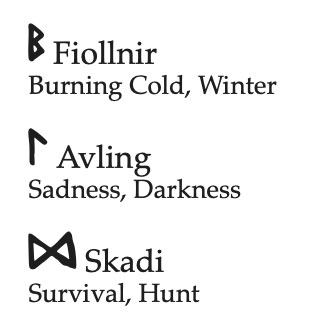
Traits are what define the capabilities of the named characters in the game. Each trait has a Rune which, when the trait is used and that Rune comes face up, adds an additional success. The traits also have a description to identify what things are possible using it. If anything you characters wish to try does not fall under one of the traits, the Master chooses the closest approximation.
Heroics are specific abilities defined as a paragraph on their character sheet. Each one has it’s own mechanical description which defines how it works. They are unique to that character and do not require a throw to use.
Talents describe something extraordinary about the character. They are used as part of a Challenge where they will provide an extra success should their Rune appear in a throw.
Resources are a key metric that defines how the game comes to a conclusion. Each Resource is either people or artifacts that are at the service of one of the characters. Each of these elements have a name, a value, and a Rune associated with it.
Resources either resides with a character, or at a specific location. When a Resource resides with a character, it can be used to aid that character in appropriate Challenges. The Resource functions like a Trait, adding to the Throw a number of stones equal to it’s value. If it’s Rune appears during a Throw it also provides an additional success.
Named characters have Traits of their own. When creating on, write down their traits – assigning numbers following the pattern of 6/5/4/4/3/3/2/2 as illustrated on the playable characters, write down one talent, and give them a Valhalla’s Calling of six (this means they have only 6 more blows before answering the call).
Each location has four parts. It has a name, a Rune, a description, and the visual representation of the place on the map. The name is how the location is identified and referenced both in play and on the Journey Chart. The Rune represents what influence is most powerful at that location, granting anyone who gets it to fall in a Throw an additional success. The description and visual representation on the map defines the location and outlines elements in the world that do not have to bought with Destiny Stones. Anything described can be used for free as part of a Challenge or as a resource to be obtained or destroyed.
Conspiracy of Shadows: Apprentice follows a strict turn structure. Each turn is broken into four phases, Trial Declaration, Journey, Warband Challenge, and Master Challenge. The alternating of turns continues until the Apprentice and his Warband choose to initiate the final confrontation with the Master.
If a Trial is ongoing, skip this Phase
The Master and Minion always initiate the game by placing their tokens on one of the marked locations on the map. The Apprentice and Warband then place their token one one of the marked locations on the map and immediately enter into the Trial Declaration Phase.
If this is your very first game it is recommended that the Warband is placed at the City of Winter, the Master is placed at the Holdfast of Nat, Volundr is placed at the Tarnemt Stone, Jargas is placed at the City of Morning Star, and Thyrm is placed at the Hall of Heroes.
Overcoming Trials is how you accomplish things in Conspiracy of Shadows: Apprentice. The goal is either to gain a new Resource, improve a Resource, to deprive your enemy a Resource, or to send the Minions or members of the Warband to Valhalla, eliminating them and their Resources from the game. This is the time to engage in role-playing as you create the narrative of the conflict between the Master and the Apprentice.
To acquire a Resource, it first must be defined in two sentences or less. It is best to load those sentences with as much detail as you can muster.
The Staff of the Wodin was the source of his ability to travel to any place in the north at any time. By cracking it upon the ground at his feet, enemies in his path fled, the seas calmed, and the ravens of the world whispered to him the secret paths to his destination.
In this example both the power of the item and it’s Rune are being defined. Enemies fleeing, seas calming, and learning of secret paths are the contextual descriptors and they total up to a rating of 3 for the staff. The Rune is also defined by the contextual descriptors as you must select one that is relevant to one or all of the descriptors. In the previous example, Trenger, Reise, or Vijir would all be appropriate. This number is also added to the base rating giving it a final value of 4. The total value is also the number of Challenges required to acquire the Resource.
To improve a Resource, you must engage in another Trial centered around it. Success allows you to increase its numerical value and add a new contextual descriptor to it. Failure means that the rating of this Resource can no longer increase for the rest of the game. Improving a Resource always takes 2 Challenges to accomplish.
One the resource for the Trial has been identified, you must next identify the problem surrounding it with a single sentence. When the Master or Minions are acting, the Apprentice identifies the problem. When it is the Warband is acting, the Master identifies the problem.
Wodin’s Staff is was locked behind Thor’s Doorstep by the Alfar.
During the Journey Phase, the Warband has the opportunity to move to another location on the map. To do so they first engage in a Journey as dictated by the Journey Chart. A Journey is a Challenge with one of two outcomes. The Warband arrives unscathed by the events or they are blown off course by the Master’s manipulations of the sea to a location of his choosing.
Upon arriving, at either the desired destination or the off course destination, the description of the location must be read aloud to the group by the Apprentice if the Warband is moving or by the Master if he or his Minions are moving.
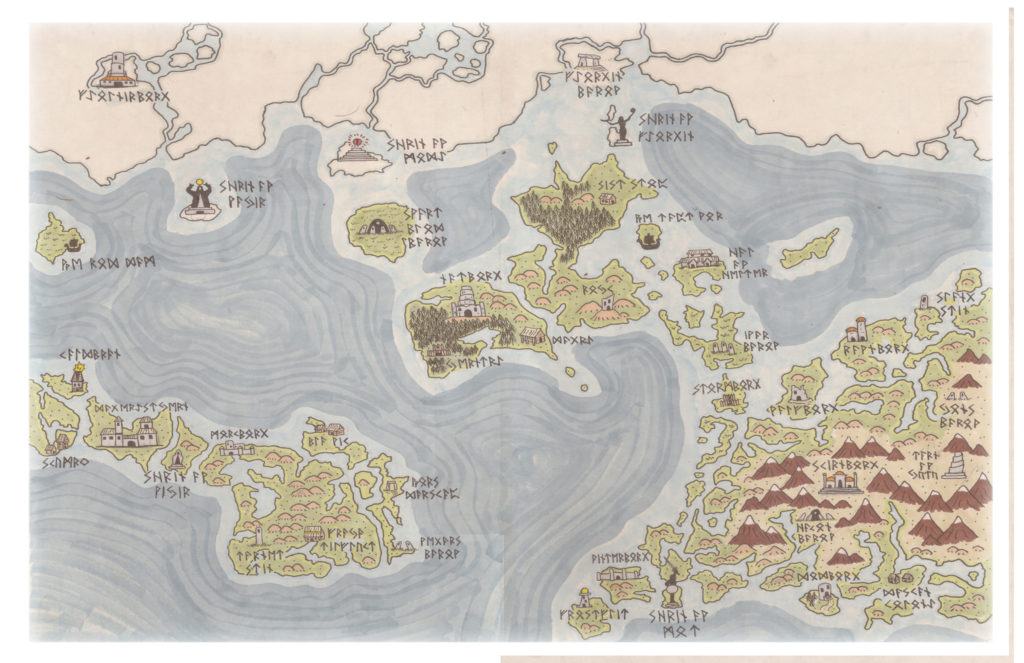
All of the locations are written in a rune language I concocted with the Futhark. Not exactly user friendly, but I love how the map looks.
On the Master’s turn, he and his Minions may each move to different locations on the map by placing their token where they wish to go. The Master automatically arrives at his destination. The Minions must engage in a Journey as dictated by the move chart. A Minion’s Journey is a Challenge with one of two outcomes. The Minion arrives unscathed by the events or he misunderstood his orders and stayed where he was.
With the Trial identified, the first Challenge must be defined. When the Apprentice or Warband is acting, the Master identifies the Challenge. When the Master or his Minions are acting, the Apprentice must identify the Challenge. The Challenge can be defined freely from the elements defined in the description of the location and by the visual representation of the map, or can be created from the use of Destiny Stones. However, it must be done in three sentences or less.
The Ring of Nimue must be acquired from Gylvi the Smith, to open Thor’s Doorstep. He is being held against his will by the Order of the Sacred Cup in Blavik, where he is chained and forced to craft for them weapons that do not heed armor made by mortal men.
This example is a typical creation of a Challenge combining existing elements as well as spending Destiny Stones to add new elements. Thor’s Doorstep, the Order of the Sacred Cup and Blavik are all free to use as they are defined within the text. However, the Ring of Nimue, Gylvi the Smith, and the weapons he has crafted for the Order each would cost a Destiny Stone to bring into play.
Once the Challenge is declared, the characters move to engage in actions to overcame it. The description of these actions defines what Trait the character will use to overcome the Challenge, and ultimately lead to a successful Trial.
Haltaf, sets off to meet with the local clans to demand their support for a raid on Blavik to free Gylvi the Smith.
In this example, the player decides to leverage Haltaf’s Lendmann skill to command the local clansmen to aid in the rescue of the Smith. The clansman do not provide any mechanical bonus, but the context of Haltaf’s actions allow the player to leverage one of his stronger skills to overcome the Challenge.
Now the previous example is fine and it serves the purpose of the game, however it is not very exciting or evocative. A good Trait description both adds fun to the game and is evocative, which is the precondition for earning Destiny Stones.
Haltaf arrives at the camp of the local clans on Skidbladnir whose very presence awed them. Speaking of strategies and the weaknesses of their enemy, he draws them into his plans to storm Blavik and free Gylvi the Smith.
This description is much more evocative and it also includes one of Haltaf’s Resources, Skidbladnir the Folding Boat, which can now be added to his Throw. That player can then role-play out the scene he has described with the other players at the table picking up roles as needed. Once the scene reaches a conclusion, the player earns a Destiny Stone.
After the scene, your opponent defines the conditions of the Challenge with two sentences. This procedure mirrors that of the Challenge definition, allowing your opponent the chance to narrate a difficult situation that translate into a Target Number. For example, the Master may describe:
The storming of Blavik is no easy feat. The clans you have recruited to your cause have suffered many defeats on their own raids, and some have even turned to the One God after being visited by missionaries. The combination of this with their martial training, the recent expansion of fortifications, and the weapons made by the Smith will make this a costly battle.
This statement uses elements that exist in the descriptions found in the text, those items already created earlier in the Challenge, as well as a new element (the recent fortifications) created through the use of a Destiny Stone. From this statement you create a Target Number the player of Haltaf must attempt to overcome. This is done by totaling up all of the relevant element.
Many Defeats + Traitors + Martial Training + Fortifications + Weapons = Target Number 6
The player of Haltaf then Throws a number of Runes equal to his Trait. If he tallies up enough successes to meet or exceed the Target Number of the Challenge, he is victorious. If not he suffers ignoble defeat.
If you overcome the Challenge your enemy describes the events that occurred that led to your victory. However, they get to convey the course of events how they like in three sentences or less. You are still victorious, but the events are painted in a light favorable to your enemies. In doing so, this gives them an opportunity to add elements to the game for free as if they were using Destiny Stones.
Haltaf leads the Yngling and Nording Clans in the storming of Blavik, bringing down the fortifications after hours of hard fighting. Upon reaching the priory they found Sir Ulric wielding a blade that shone with the light of the One God. He slew many before he was forced to retreat, vowing vengeance against those who freed Gylvi the Smith.
After this description, the Master may now place one of the Conditions listed below upon Haltaf. These conditions last through the entire Trial.
The failure of the Challenge also has an impact on the Trial as well. The description of the failure redefines the the next Challenge that needs to be met and forces another member of your side to deal with the situation. Your failure precludes you from trying to overcome this Challenge.
Teamwork is a central part of Conspiracy of Shadows: Apprentice for the Warband, which always moves together from location to location. The master and his Minions may never take advantage of Teamwork.
To utilize Teamwork, a player who wishes his character to help must describe his actions in a single sentence after his ally describes his own actions. In doing so, that character is defining what Trait he is using to aid his ally.
Freya the Silent leads the clans through the surrounding woods via secret paths, allowing them to arrive unnoticed.
This example defines that Freya is aiding Haltaf by using her Hunter Trait. Mechanically, she is adding her own Trait rating to Haltaf’s Throw. Therefore Haltaf now Throws 13 Rune Stones instead of 7. However, if the Throw fails, the master will grant both characters Conditions he feels are appropriate to the context of the events.
At any time in the game, when a character is facing another named character except the Master, he may call for Glorious Battle. In this case, the normal Challenge resolution is tabled and the characters enter into a one-on-one combat event. Instead of events centering on a single Throw, a series of Throws happen simultaneously in this fight to the death.
The player who called for Glorious Battle first describes his attack in a single sentence and through that description defines what Trait he is using.
In this example the player of Freya is leveraging her Hunter Trait [6], her Loyal Wolf Resource [2], and her Wolf Friend Talent. This means her Throw is 8 Rune Stones with the opportunity to gain further successes if any of those stones come up with Runes that match her Trait, Resource or Talent.
The player of Sir Ulric, which is always the player who brought the character into the game, now describes his defense with a single sentence. This description defines the Trait he will be using.
Freya and Geri, after stalking Sir Ulric through the woods around the Aery for hours, finally pounce when he stops to give his mount a drink at a bubbling stream.
Sir Ulric looks up, forewarned by his mount’s sudden skitishness, draws his sword and gives out a war cry damning Freya to the Hell of the One God.
In this example, the player of Sir Ulric is leveraging his Hirdmann Trait [5] and his Shining Sword Resource [1]. This means his Throw is 6 Rune Stones with the opportunity to gain further successes if any of those stones come up with Runes that Match his Resource or Trait.
The character who throws highest deals damage to his opponent, bringing him closer to Valhalla’s Calling. The damage is equal to the difference between the two throws. The Glorious Battle continues like this until either one of the two warriors answers Valhalla’s Calling (12), or one of the warriors flees in shame.
A character that flees in shame is branded a Coward. This brand lasts with him until he redeems himself, forcing him to Throw one less Rune Stones in all Throws. Redemption can only be earned by winning two Glorious Battles whose tales drown out those of the character’s earlier shame.
It is important to note that Valhalla’s Calling is not a measure of how much punishment a character can take. It is a measure of how close a character is to having his fate come to pass. The three Fates only draw your thread out for so long before one of them cuts it.
The Litany of Heroes serves as living narrative of the trials and tribulations of the Apprentice and the Master while also serving as a mechanical record of everything in play. It marks every Challenge overcome and every Glorious Battle by every character in the game. The document is created collectively by every player in the game. It is the responsibility of each player to write down a narrative of the events their character was a part of in this single document.
If something is not recorded in the Litany of Heroes, it did not happen, literally. If at any time you fail to mark something down during the game, all of the results are forfeit. You must roll back any changes to your character sheets. This is not negotiable.
The last turn of the game begins when the Apprentice and his Warband feel they have built up enough Resources in their estimation to confront the Master in his own lair. Facing the Master in his lair is not done lightly as failure here means the end of the Apprentice and possibly the entire Warband.
During the Warband’s Trial Declaration Phase, the Apprentice declares that the final confrontation is at hand, and that he and the Warband are moving to face the Master. The Master then describes his lair and the Resources that are arrayed there to defeat the invaders. The Challenge Phases are then followed in the same order as the rest of the game and do not end until either the Master or the Apprentice is defeated.
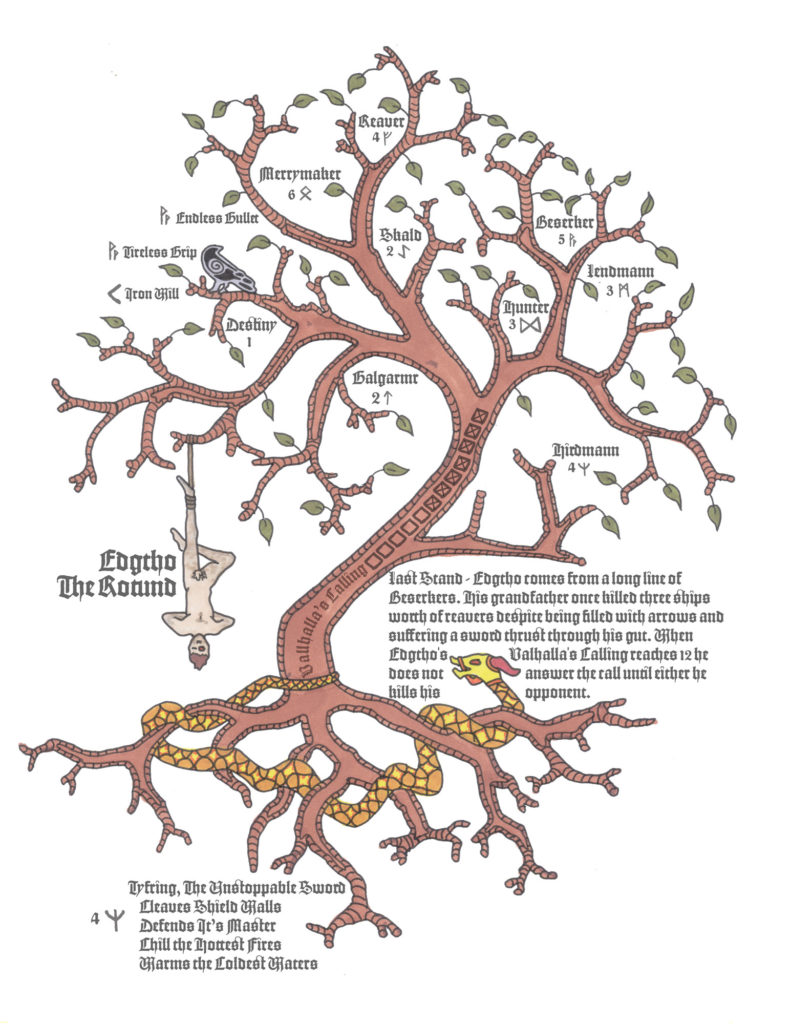
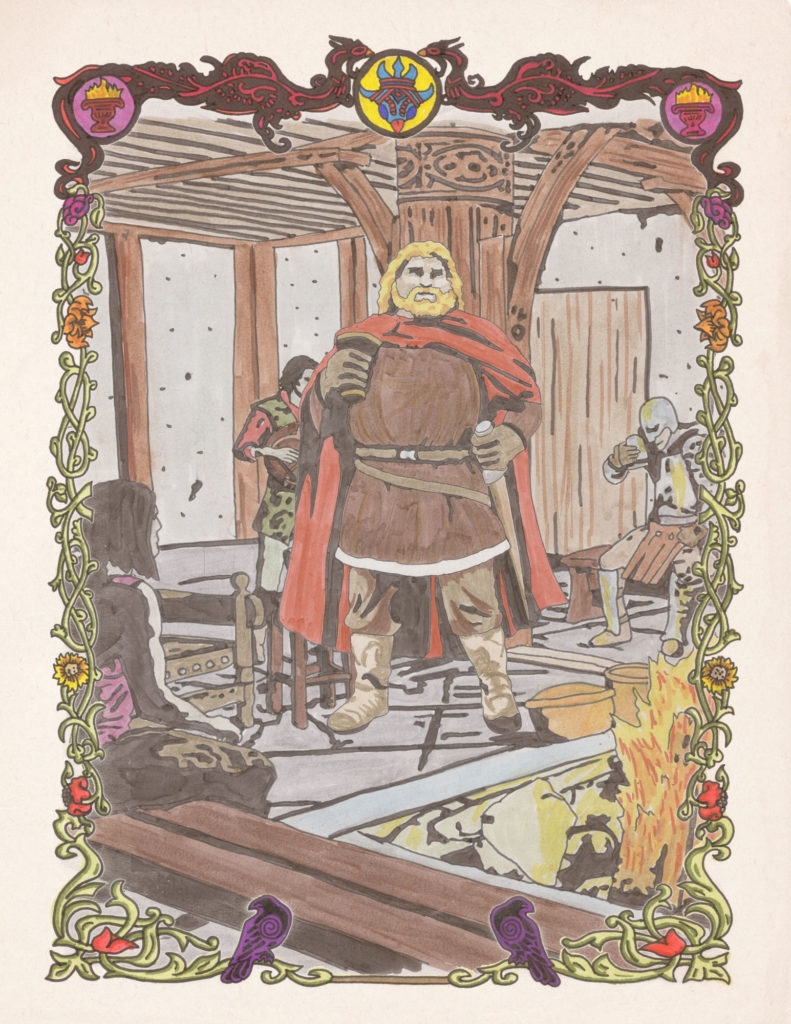
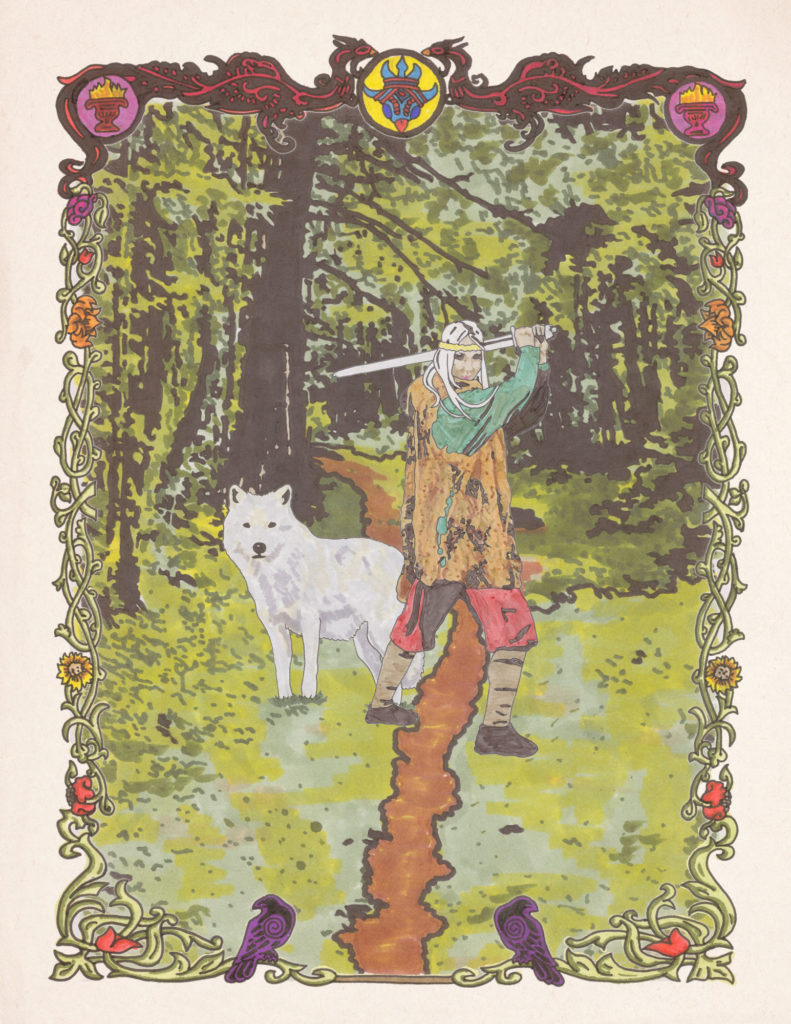
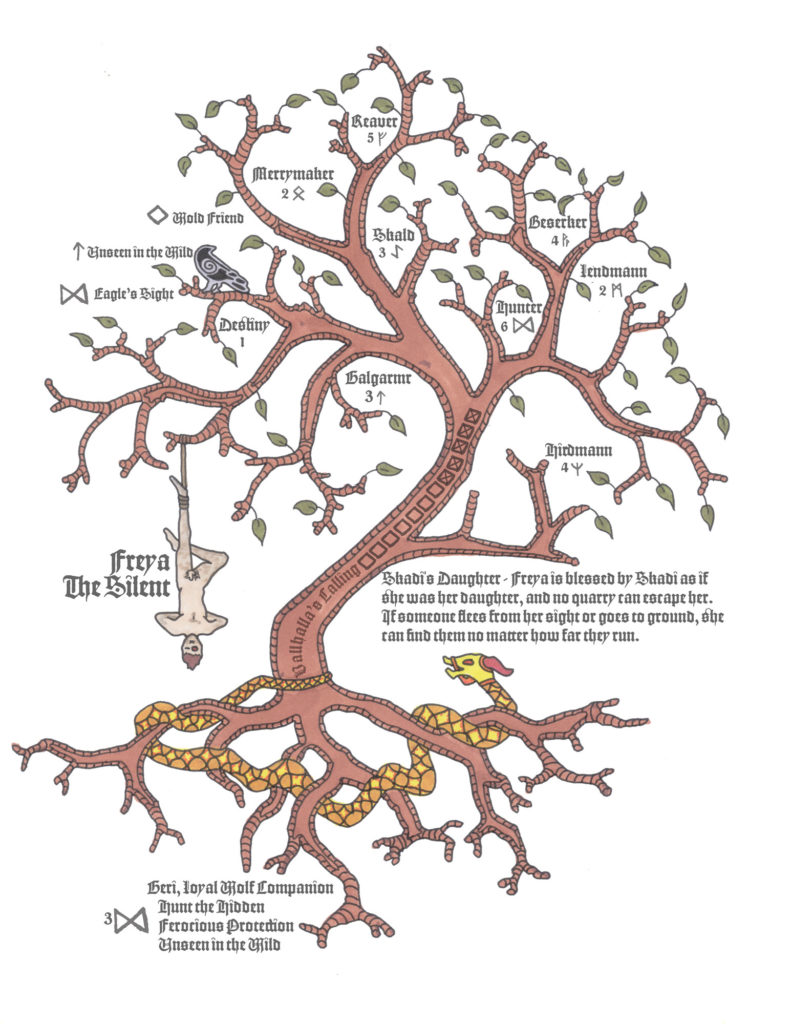
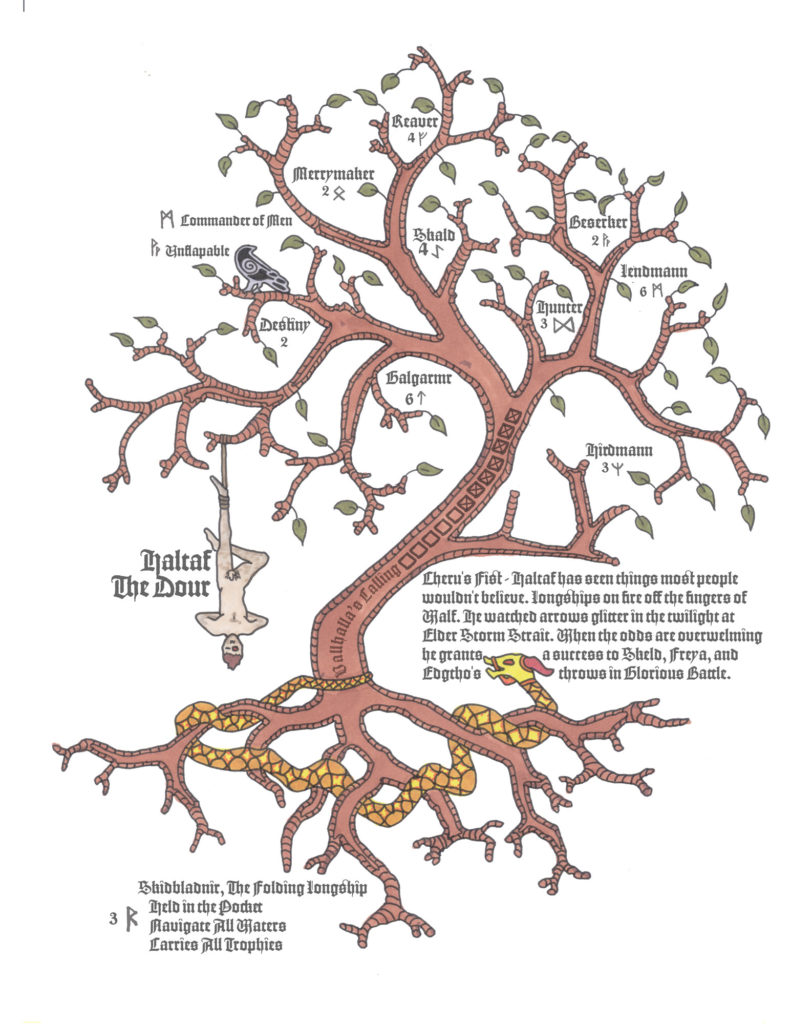
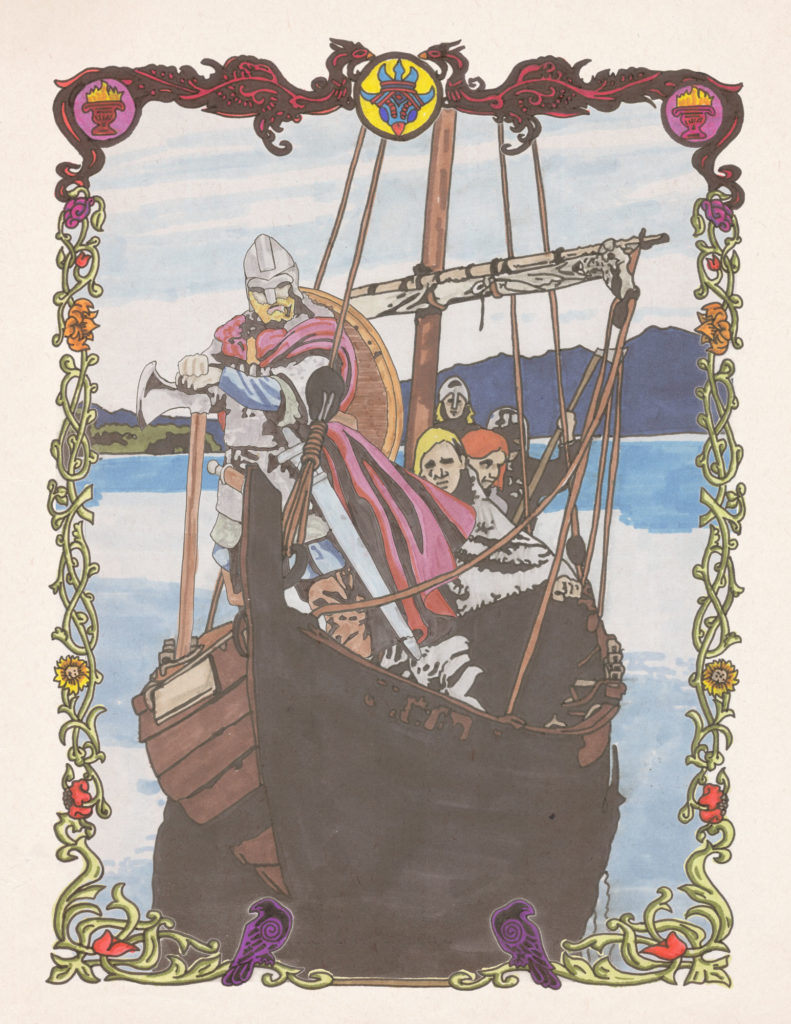
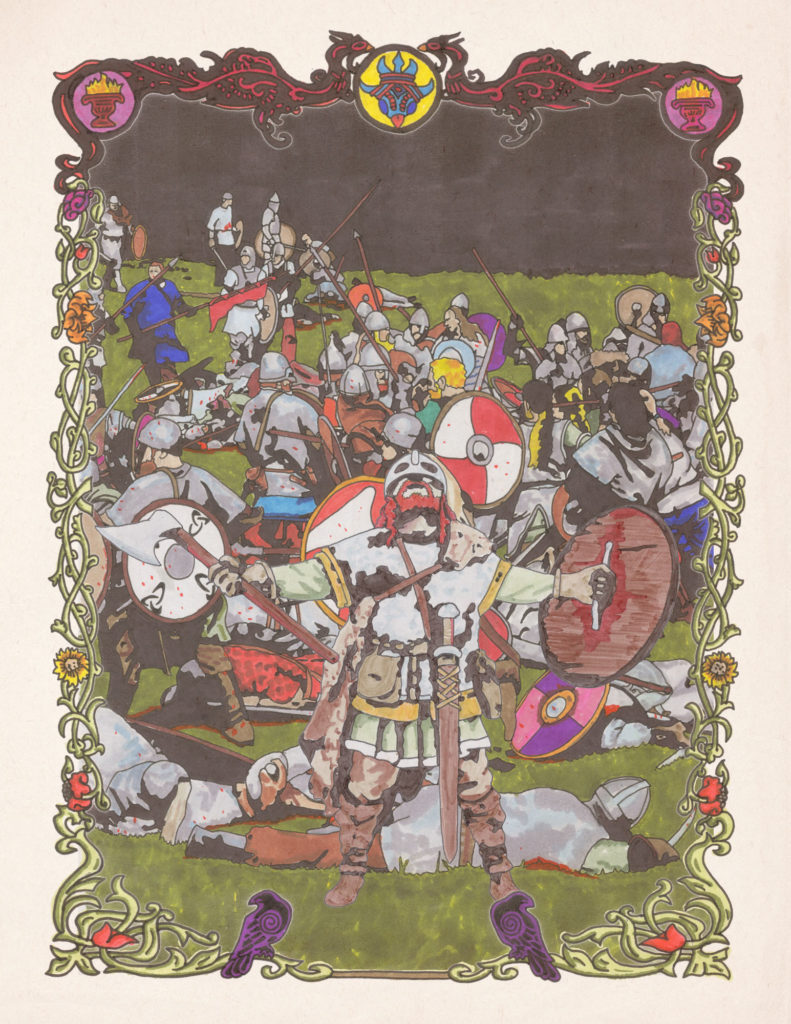
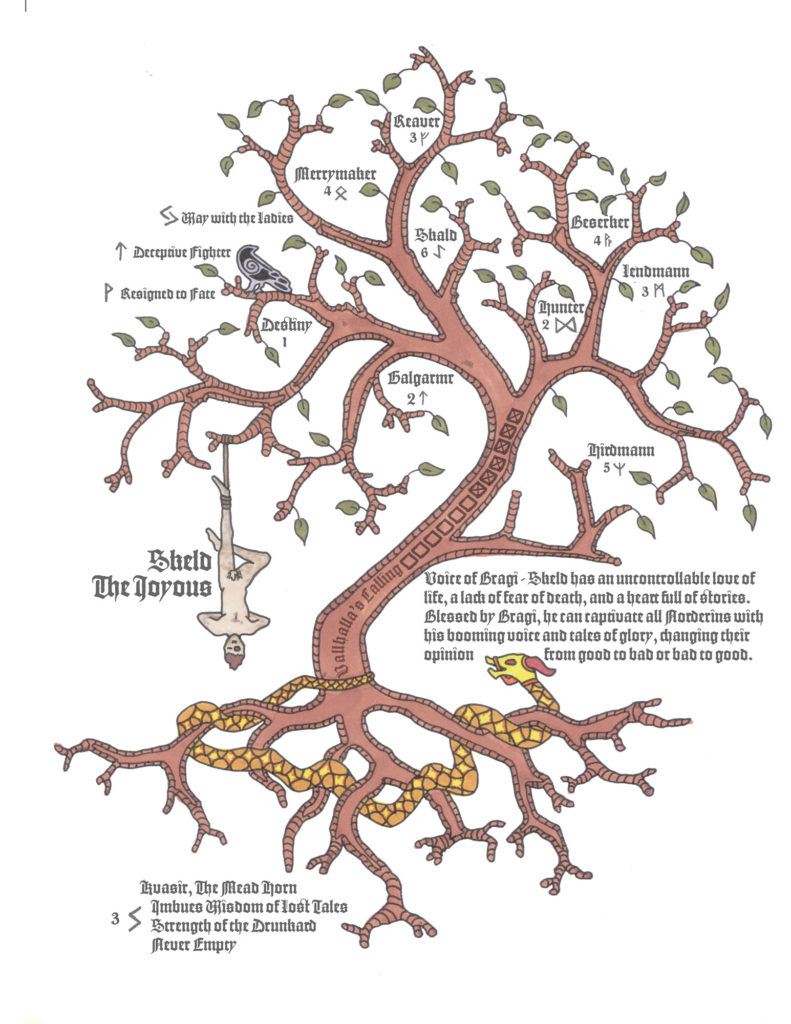
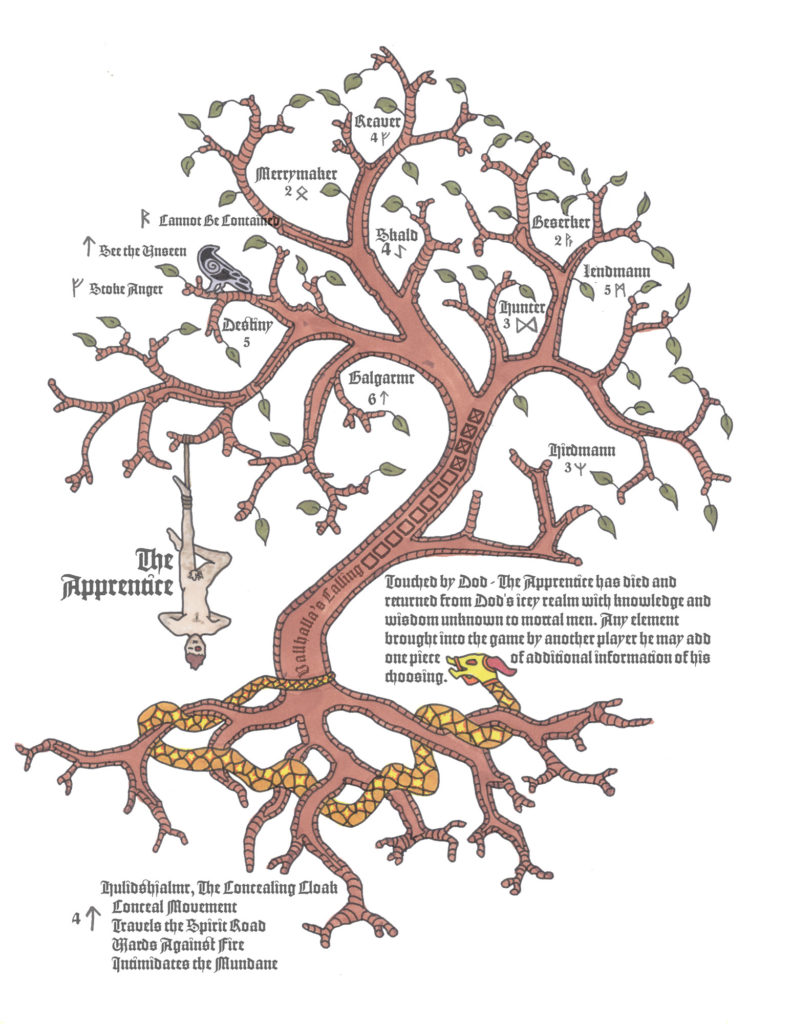

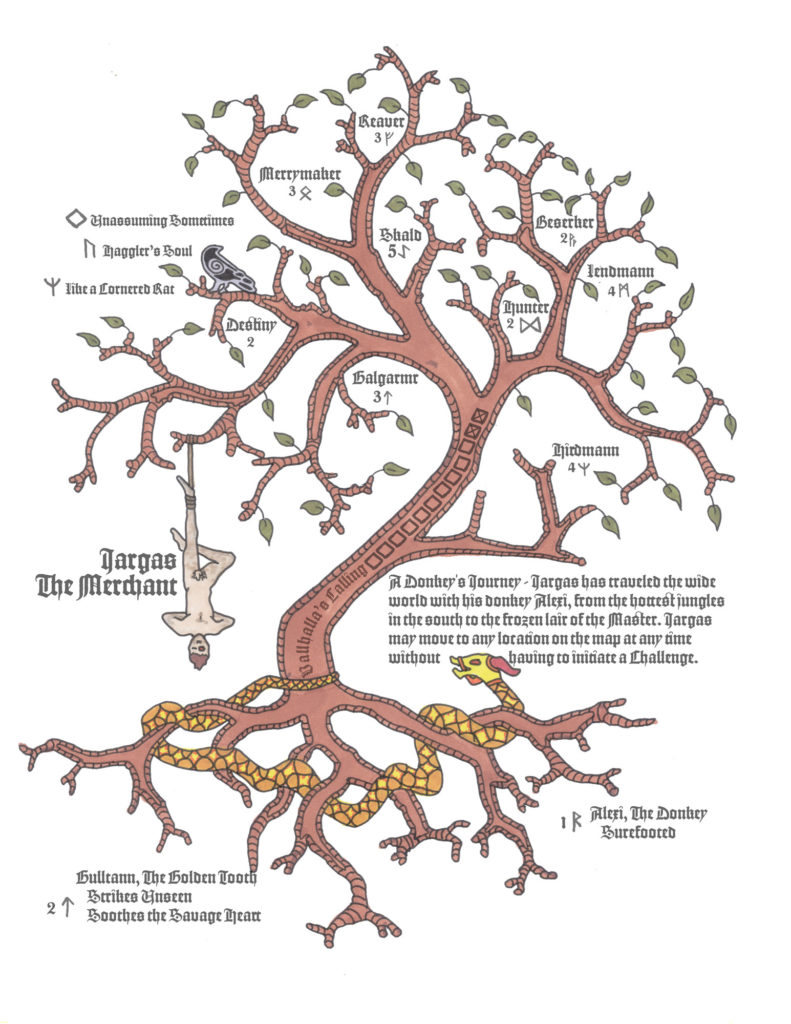
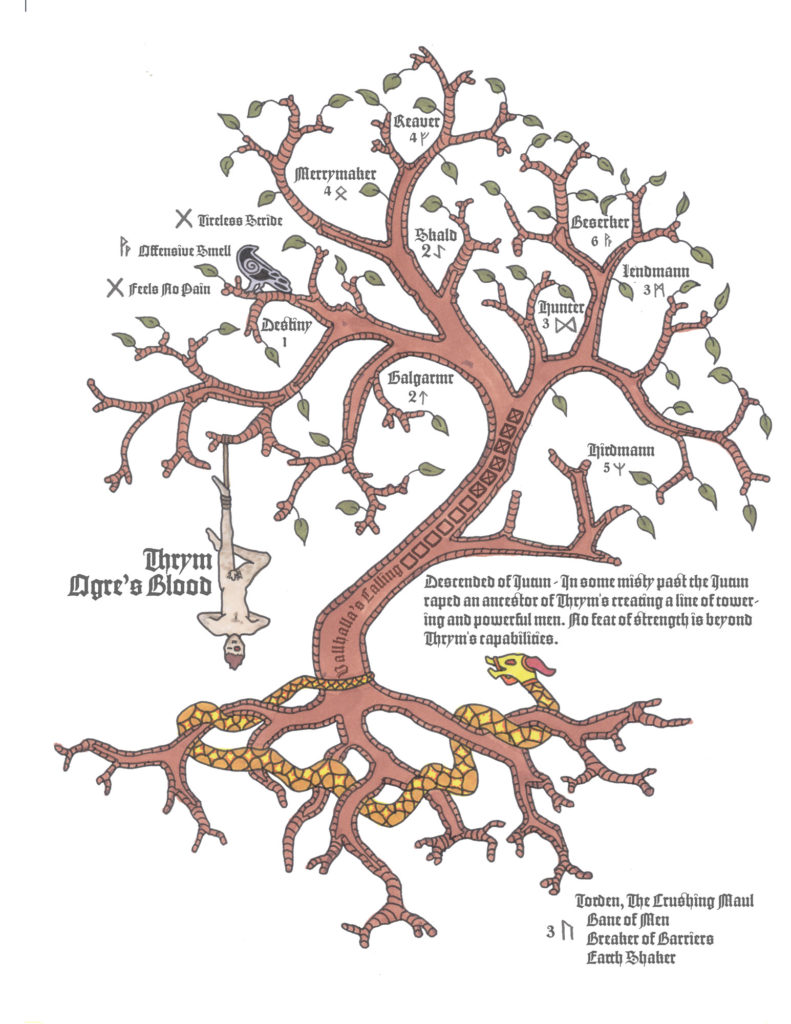
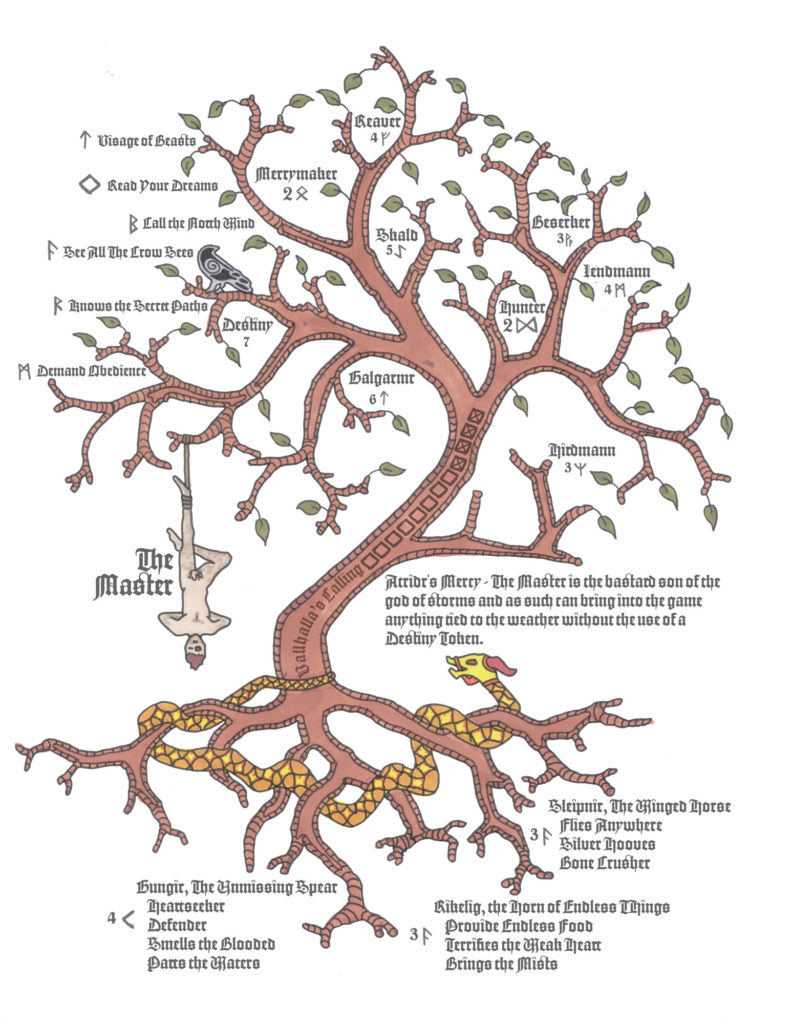
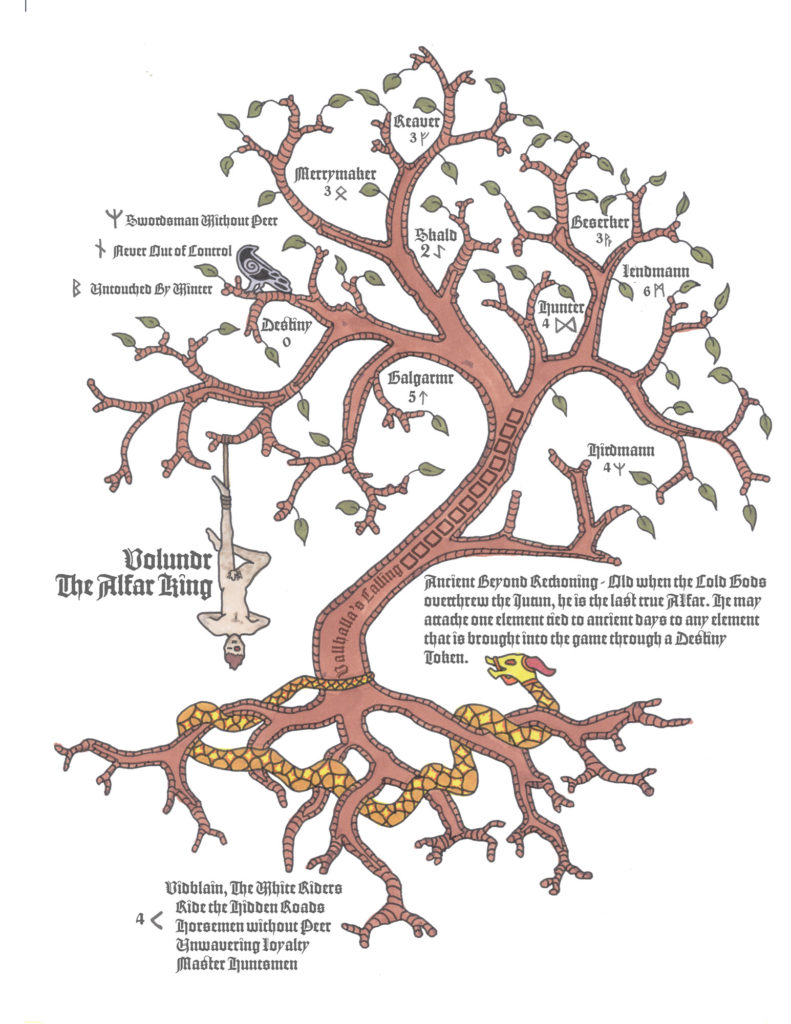
Morning Star is nestled centrally in the island chain known as the Fates. It is governed by Jarl Skadi Sigurdsson, a cruel tyrant who actively supports Hadvar and his Taptwar Reavers. From his holdfast overlooking the city he acts on every animal impulse, only given pause when he faces power he cannot understand.
The city itself has been raised and rebuilt a dozen times over the last 100 years as it has suffered fires, raids, and several mad Jarls. If it wasn’t for the abundant iron found on the island, it would have remained uninhabited. Despite this, it is the home to the only library to be found in all of Navari. It is the only building to never fall to the flames, raids of jarls.
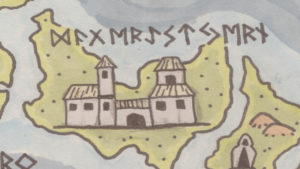
East of Morning Star stands the lesser shrine of Vijir. Made of a small boulder of dragon glass, it is the meeting place for many different types of worshipers of Vijir. During the fool moon, true born Vargs gather here to hunt at their lord’s behest. On the summer solstice berserkers bring their sons to initiate them into their mad lifestyle and on the winter solstice, it is said witches meet to celebrate their lord’s blessings. No one who speaks of these things has ever witnessed them and the Librarian is surprisingly silent on the issue.
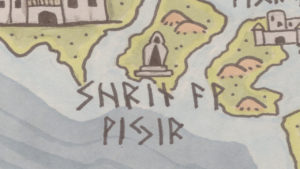
The Holdfast of Mork sits astride two islands, splitting the seat of Clan Rorir into two quarters, one well off and one home to some of the worst people to be found in all of Navari. Mork is the center of all drug trafficking in Navari, with the poor of the city suffering from the trade while the heads of the clan reap the rewards.
Jarl Jagr Blacktooth rules the city in name, but is a drunken fool and so his nephew Sarn is said to rule through him. It is believed that he has built a network of informants and agents across the entire region in every brothel, gambling house, and thieves den.
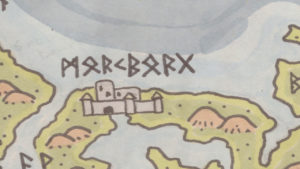
The Tarnet Stone is said to mark the entrance to the land of the Alfar in this region. Using ancient rituals known to the First Men, a great rend in the world could be opened here to allow men to cross into the land of the Alfar to plunder their riches.
Of course, nothing about the Alfar is ever simple and no door is not without it’s guardian. The Librarian of Morning Star believes that once the rend in the world is made, the Gatekeeper will step forth to destroy those who seek the lands of the Alfar. According to tradition the Gatekeeper is a monstrous creation forged from the flesh of the dead, sewn together with thread made from the silvery hair of Alfar maidens.
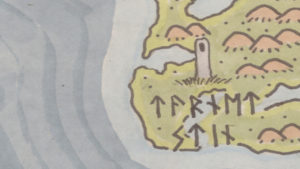
Blavik is a unique place in the region as the village was established by the Order of the Sacred Cup, a militant religious order from the south. The village is centered on a chapel and priory to the One God, which house priests and warrior monks who are determined to turn the Norderin people away from their worship of the Cold Gods.
There are nine knights who rule the village, though it is not uncommon for others to pass through on their way to guard missionaries spreading the faith throughout the north. Several clans have led raids against the village and have all been turned back. Those whose pride was most damaged by these defeats have offered generous rewards to anyone who can bring the knights to their knees.
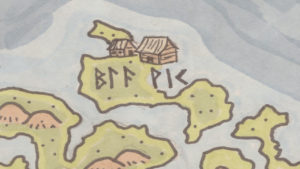
Thor, son of Jons, was as much a monster as his father. However, instead of turning his dark desires upon his people he focused on the Alfar. He hunted them, enslaved them, and tortured them. He sought the secret of their immortality and in the end it destroyed him.
Thor’s Doorstep is all that remains of the city he had his Alfar slaves build. After his death at their hands, they tore it down, brick by brick, leaving only a rune covered doorstep, which was constructed by the Galgramr Wodin. It is believed that on certain nights, by walking through the doorstep, you can be transported to the city at the height of it’s power. Many have tried in hopes of bringing back the great riches and powerful magic of that time. Only one man has succeeded, Baldr of Blavik.
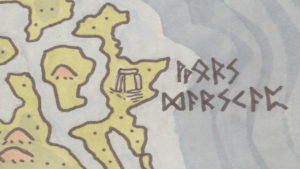
Kaldbrain is a village northwest of Morning Star that is centered on a strange impenetrable tower whose top is always burning with a mystical flame. The architecture of the tower is entirely foreign to the region and though there is no entrance in or out, voices can often be heard inside speaking in unfamiliar languages.
Around the tower, the village is mostly unremarkable. The people are mostly fishermen or herdsman, though the Black Hand mercenary company has recently begun constructing a keep here. Many of their members have chosen this sleepy village for their retirement having completed tours in both the Clan War and the Tarathan Civil War.
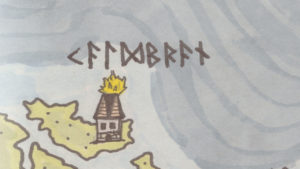
Fraja Tilfaukt is an odd village of 30 souls that sits on the edge of a marsh. The strange name is said to come from the Dvergr who once made the place their home, forging fine works of metal and stone. Their legacy can be seen in the many stone buildings in the village that have a much higher degree of craftsmanship to them than any other found in the region.
It is rumored that several inhabitants of the village have disappeared of late. Locals speak of strange lights in the marsh and of odd grinding and clanging sounds ringing out through the night. Some fear that the Dvergr have returned to reclaim their home.
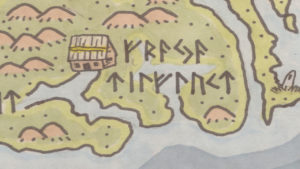
During the rule of the Jutun they were served by human priests called Jutlings. The Jutun granted them small amounts of their power in exchange for total loyalty. At the height of this power they made the Holdfast of Feolnir their home. Here the highest ranking priest met within the temple to forge laws and craft artifacts of power.
When Vijir, Vojin, and Vajir revolted against the Jutun, their first act was to attack Feolnir on the summer solstice, when all of the Jutlings were in attendance. With great magic they cursed the populace with life eternal, so long as they remanned within the hold. It is assumed that they all eventually threw off immortality to walk off into the snow to die, but the Librarian of Morning Star is not so sure.
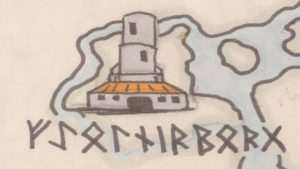
To the southwest of the Shrine of Modi stands the towering Shrine of Vijir. Made of a solid piece of dragon glass, it seems to shimmer and change shape when the lights of the aurora hits it. At its feet stands a bronze door that is said to bar the way to Vijir’s hoard, which can only be reached by those worthy of his cunning challenges. No one has been worthy since the fall of the Jutun.
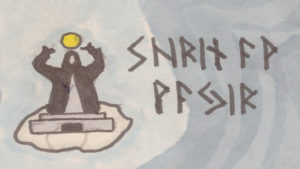
The Red Dame was a merchant vessel out of Winter that twenty years ago ran afoul the shoals near the island where it now lays. The crew was able to put into shore, but the ship was unsalvageable so they made themselves a home out of it on the island, living off of seals and fish. Eventually a town grew up around the ruins of the ship as more and more merchants and reavers stopped on their way to Navari.
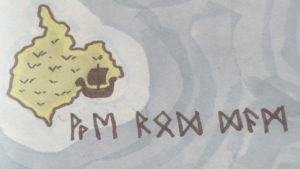
Swart the Blooded was the Konge of Navari shortly after the death of his grandfather, Jons. He was not like his grandfather or father and did not give in to his dark impulses. He went so far as to banish the worship of the Cold Gods all together. This act probably explains his legendary death at the hands of Skadi and her Wild Hunt.
His barrow is said to be the last of its kind, built in the old style where the Konge was buried with the bodies of his Hird, who were forced to fight to the death so they could server him in Valhalla. It is also said that he was buried with the Dragon Crown, which is said to have been forged from the teeth of the last wyrm of the north, Nari.
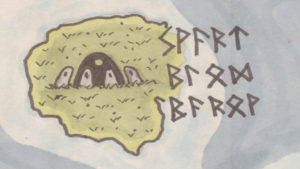
The city of Winter is always cold and covered in snow due to its location at the tip of Jutun’s Finger. Its streets are lined with braziers kept burning day and night so that the citizens don’t freeze to death. Everything is built of petrified wood harvested from beneath the nearby hills, creating a somber dark atmosphere.
Jarl Torygg, known as the Wolf of Walfhold, rule Winter through cunning and guile. It is said that during the Clan War he ruthlessly took Walfhold to secure the Jutun’s Finger for the Konge. Women and children were tortured to give up the names of all the surviving Walf Clan members. All who opposed him, even in the smallest way, were executed.
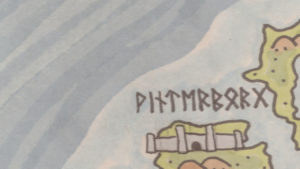
The Frostflit lighthouse sits at the very tip of the Jutun’s Finger, lighting the way for ships coming from the south to trade in the City of Winter. It is kept by Hadvar the Stone, the last member of the Gravyrnn Clan. The people of Winter believe he is in fact a member of the Brotherhood, an organization of assassins from Taratha. The rumors are only fueled by the fact that he made his living as a mercenary fighting in the many civil wars in that country.
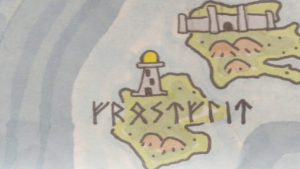
Vegar’s Barrow is both the final resting place of an early Konge, Vegar Blue-Fingers. It is also believed that his barrow sits upon a lost Alfar city, hiding it from men and Alfar alike. Legend states that because Vegar was spurned by an Alfar princess he built his barrow over the entrance to their home, having it enchanted by a powerful Galgramr to keep any who enter the city from escaping.
The Librarian of Morning Star is said to be interested in a particular statue from this Alfar city, and will handsomely reward those who return it to him. A small number of people have tried to recover it, but none have yet returned.
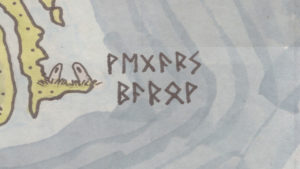
Skumring is a village across the straight from Morning Star, tucked away in a treacherous, mist shrouded fjord. A mining community, it was founded three generations ago by the Stodi Clan, who where worshipers of the Deep One. Thirty years ago the Jarl of Morning Star burned the village temple to the ground because of this cult, slaying the high priest. However, Bibles of the Deep One have begun to surface in other communities recently and rumor has it that the Brethren have returned to Skumring.
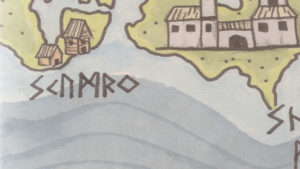
To the southeast of the city of Winter stands the massive shrine to Mot, the god of glory, courage and single combat. It is said that this shrine stands over the shattered city of Jagar. In the misty time before men were given the wisdom of Vojin, Mot laid waste to this marvelous city of the Jutun, but not before being mortally wounded by their living god, Malex and Zotha.
Today, warriors make pilgrimages to the shrine to battle with one another as a tribute to their dead god. Those that don’t fight venture into the subterranean ruins of Jagar, seeking glory and the riches of a long dead civilization.
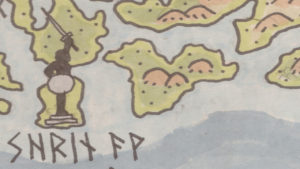
The Holdfast of Storm was built after the Clan War to monitor the clans to the north of Jutun’s Finger. Today Clan Korir calls it home where they use it as their base to hunt the surviving clansmen of Clan Walf as well as fight off the Taptwor Reavers.
The Jarl of the Korir is Brunwulf, a man beaten and broken by the horrors of a life spent at war. It is known that he worries that his son and heir Farengar has succumbed to the same blood madness that consumed him as a younger man. Clan members and strangers alike in the region fear that with the acquisition of a new rune blade, Farengar has somehow become even more bloodthirsty and may turn on the common people.
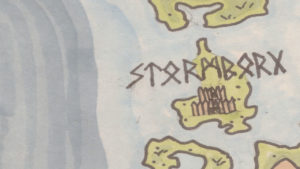
Dod is said to be named after the great hero of the Jutun War and friend of Vijir, Dodridr the Mad. It sits on an isolated foreboding island surrounded by hidden shoals and is ruled by Jarl Hroggar, who some believe is a sorcerer. The people of the holdfast do not travel at night, though from their windows they often see looming shadows and green lights in the distance.
The people of Dod, when they choose to speak to strangers, will tell of Thornir, who disappeared into the woods 50 years ago. It is said that he murdered his wife and young daughter in favor of his lover, a stranger from lands distant, warm and green. The townsfolk rose up and tried to kill him, but he escaped using strange powers and now makes his home in a series of caves somewhere in the surrounding woods.
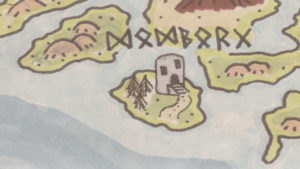
In a wind swept fjord north of Dod lies Haakon’s Barrow, the legendary founder of the Norderin people and the man from whom all the Konges claim their ancestry. Spreading out from the location of this barrow, which was once the capital of Navari, he lead his people in a genocidal war against the Alfar.
The war with the Alfar culminated when he slew the Night King, though he took a mortal wound for his trouble. His people took his body to the capital, converting the city into a massive barrow. There they entombed him with his axe and all those warriors that had been slain in his service. It is said that with the recent stirring of the Alfar smoke as if from a camping army can now be seen rising above the barrow.
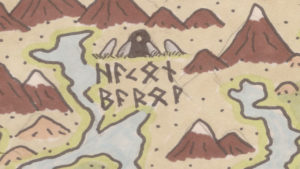
Norderins are not the only people to call this region home. Thirty years ago a small army fleeing with their dependents arrived in search of sanctuary from the civil unrest occurring in Oldaska. The Jarl of Winter granted them permission to build their town in exchange for guarding the eastern trade routes.
The colony is ruled by Radek of Dro, the son of Lukasz, the founder of the colony who was broken on the wheel by the Taptwor Reavers. The people whisper that his ghost stalks the colony wreathed in fire, bringing death to those that displease him and wisdom to those he favors.
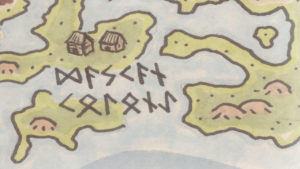
High atop the mountains of the Jutun’s Finger lies a cyclopean fortress carved out of the living bones of the world. In the time when the Jutun held dominion over all the world during the long winter this place was least among their cities. Despite this the horrific marvels of the city defy human understanding.
Today what remains of this vast ruin is either overrun by trolls or the servants of the Jutun who still go about maintaining the city as they did an age ago. It is also said that the Huldra also makes this place her home, enticing the adventuresome to their doom.
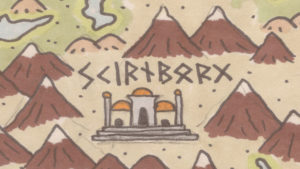
When the Jutun were overthrown by the brothers Vajir, Vojin, and Vijir not all men threw off the yoke of slavery. These men became known as the Jutu and in the wake of the Great Rebellion they took one of the homes of their former masters, the Tarn, and made it their own. Today the Tarn has become a place of pilgrimage where men climb the 10,000 steps to seek the enlightenment of an age long dead.
It is said that the Jutu are no longer men, but something both bestial and wise. They can both be savage and horrific as well as serene and beautiful. What this truly means is unknown to all save those who have sought to climb the 10,000 steps.
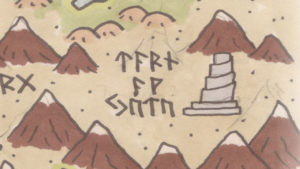
North of the Tarn of Jutu stands Jons’ Barrow, a sprawling underground labyrinth within which is buried the Konge of Corruption. In the mythic age after the fall of the Jutun, Jons studied their ancient and horrific blood magic in an effort to discover the immortality denied to him by the Cold Gods. With that knowledge he drew dark men to his cause and eventually sought to conquer all of the north.
For a hundred years he ruled the north like a dark cloud until he was laid low by an unnamed warlord from the west. He burned the remains of the Konge of Corruption, but before the ashes could be cast to the wind, his followers stole them an entombed them in the barrow with all of his artifacts of power. Now it is whispered that something stirs in the barrow.
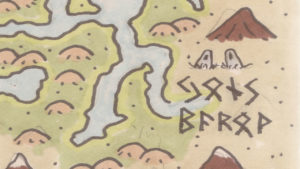
The Walf clan was founded by Hroldan Red Wolf, a great warrior who united and lead the ten warring konges who ruled Jutun’s Finger hundreds of years ago. When the modern line of Navari kings invaded, he refused to yield and fought until his death at the hands of Harald the Red. Harald was so impressed that he anointed Hroldan’s son Walfric Jarl of Walf.
For centuries the Walf clan was loyal to the Konges of Navari until the Clan War broke out and they sided with the elder prince. This proved the clan’s doom as their hold was shattered and the surviving members scattered. However, despite the destruction, rebels, scavengers and reavers have taken up residence in the ruins, some said to be searching for Hroldan’s blade, Red Wolf’s Fury.
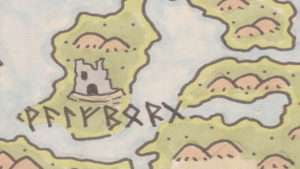
When men speak of Rawn, they first lock their doors then speak in whispers. Rawn is a sprawling castle that rests on a secluded island east of the ruins of Walf. There Jarl Harkon rules Clan Tholki absolutely, which has lead to whispers of dark powers ensuring his people’s loyalty. It is even said that Jarl Torygg is uncomfortable in Harkon’s presence, having visited the hold only once since the end of the Clan War.
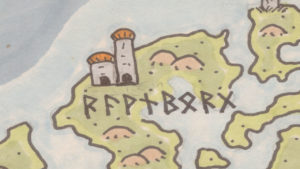
In the ancient days when men and Alfar alike were the slaves of the Jutun, the two people would meet at secret locations where the lands of the Alfar and men overlapped. These locations were marked by stone monuments carved from the very bones of the world. It is said that the Slang Stone was the first such location, but like all secrets was eventually found out by the cunning Jutun. There they laid an ambush and slew the Alfar and men who dared resist their rule.
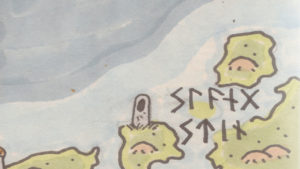
A large forgotten temple to Beli, Ivar’s Barrow is now home to the dead and the restless dead. Once it was home to a thriving community of warriors that sought to live up to the standards of their God. However, an unknown catastrophe fell upon the town, leaving only death and ruin. There are whispers that a great treasure of Beli still sits in the dead hand of his high priest.
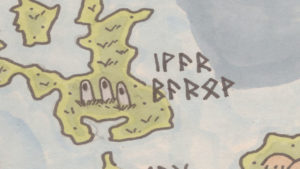
Southeast of Siststop there stands a bastion like no other in the north. Here stands the Hall of Heroes, the great manor built by the Nine Heroes of Mot after they imprisoned Fiolnir. Today it is now home to their descendants, a cohort of warriors whose mission is to find glory in battle against monstrous enemies.
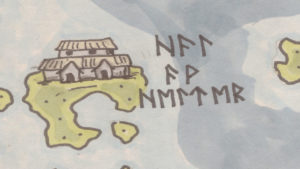
Rojk is an ancient ruin that sits upon the highest hill of the island of Njorn. It is a large tower with a dozen floors as well as a labyrinth of tunnels beneath. The men of the village of Dagree say a great Galgramr once made the tower his home. There he accepted tribute from all the islands of the north before he destroyed himself using the forbidden arts. Today they say they can still see fires burning from the top of the ruin from time to time and occasionally hear screams on the wind.
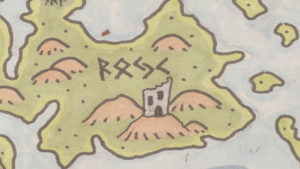
Sistop is a small settlement of fishermen nestled near the edge of the Alfar wood. The Sigr Clan, renown for their scholars and occasional Galgramrs, makes this village it’s seat of power. Unlike other clans, they do not reside in a great keep but a series of small long houses, belying the image of noble warrior chiefs.
It was not always this way. In the village green there is a patch of ground on which nothing grows. At this spot a great scion of the family died fighting one of his own creations, a golem made of the human fat of 100 men. It is said that this one act is what redeemed the clan in the eyes of the Konge allowing them to remain in existence despite the madness that sometimes afflicts their numbers.
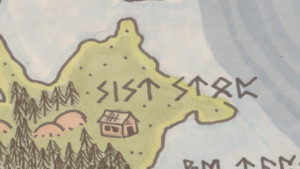
The Taptwor is the not so secret hideout of the Taptwor Reavers, a ruthless band of berserkers who raid up and down Jutun’s Finger, preying on their own people. They are ruled by Jarl Hadvar, who pays lip service to the Konge while accumulating a vast horde of wealth. Several expeditions have been sent against him from other Jarls, but with little or no success. Still they try because of the many valuable things he is rumored to possess.
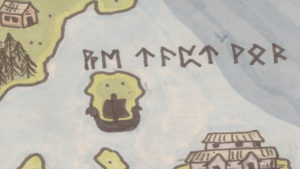
The Holdfast Nat is a high spired keep of gleaming white stone that rises out of the Woods of Corruption. Long ago it was home to worshipers of Sannhet who protected the people of the region. Their guardianship came to an end when a band of Alfar invaded the vast complex.
Legend states that as the battle went in favor of the Alfar, who sought to seize the Umbra, the priests of Sannhet released the Red Gloom. The Red Gloom froze the attackers and defenders in time, where they continue to fight without end.
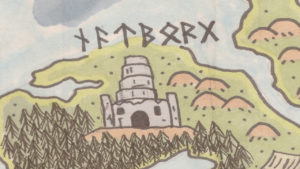
Dagree is a small settlement centered around the Black Tree Inn and an iron mine owned by the Kjeld Clan, whose members make up the majority of the citizens. However, the village has a dark past, where long ago the inhabitants trapped the original rulers, the Stir Clan and killed them.
It is said that the Stir Clan was cursed by a passing wise man to transform into wolves every seven years to mark the seven days they tortured him. During one of those transformations, the villages rose up and slew the Stir Clan, though some whisper one scion of the house escaped and still lives today.
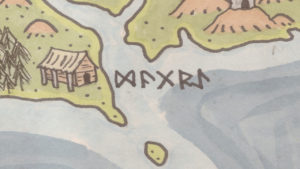
Jerntree is situated on a small pennisula from which Jarl Kazmiriez, a Daskan servant of the Konge, guards the Mistcloaked Straight and the village of Dagree. He has an experienced force of warriors at his disposal as well as several ships to hunt down pirates. A pragmatic and taciturn man, he has little patience for anyone who has not sworn allegiance to his lord.
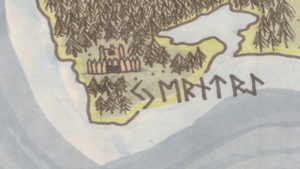
Towering over the ever shifting pack ice, the great marble statue of Fiolnir marks the only shrine to the Mistress of the Burning Cold. Huddled around the massive statue are 40 small stone buildings in which no fires burn to thaw out the frozen bodies found within.
The only inhabitant of this lonely windswept shrine is the Seer, the last priestess of Fiolnir. It is said that before coming here, her people resided in the warmer lands to the south. After receiving visions of a coming pogrom they fled here, building this shrine.
However, sometime after the completion of the shrine, their great relic, the Cold Flame of Ulfric was stolen, and so Fiolnir cursed the people by freezing them solid. It is said the Seer will bestow the Gift of Fiolnir on the champion who returns the artifact and free her people.
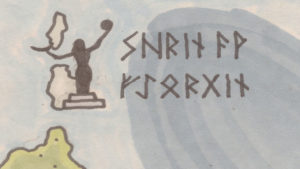
It is said that there is an evil in the north and it’s name is Fiorgin. A great barrow squats upon the last bit of rock found before the Thulean ice. Here, Fiorgin, a powerful Galgramr from another age was locked inside with his honor guard to sleep as the ancients did not have the craft to destroy him.
Now, he is locked up no longer, and his honor guard has been seen as far south as the ruins of Rojk. At the town of Siststop a mumbling madman known as Valdimar the Prophet cries incessantly about the horror that has awaken in Fiorgin Barrow and kidnapped his only friend, Torvar the Pale.
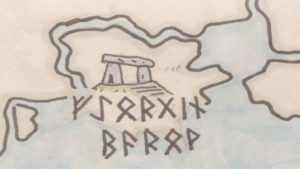
On an island permanently covered in ice stands a structure like no other in all the north. A ziggurat rises out of the ice 60 feet into the air, with an ever glowing orb at its pinnacle that looks disturbingly like an eye. The Norderens have named it the Shrine of Modi, but the Librarian of Morning Star believes the place has another purpose.
In old moldering scrolls, the Librarian found mention of a people from beyond the ice who once would come south demanding sacrifices of the Jutun. These sacrifices took the form of great hunts, where Jutun nobles fled out onto the ice to be ritually hunted and slaughtered by these mysterious lords from Thule. The ziggurat, he believes, is their great hunting lodge, where they sleep, waiting to hunt once again.
